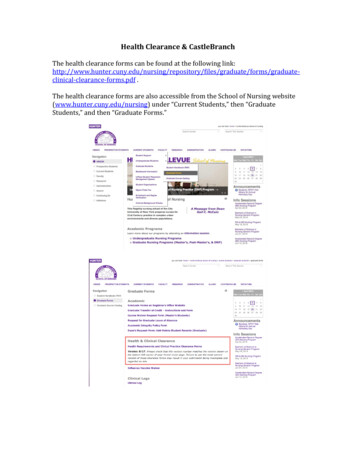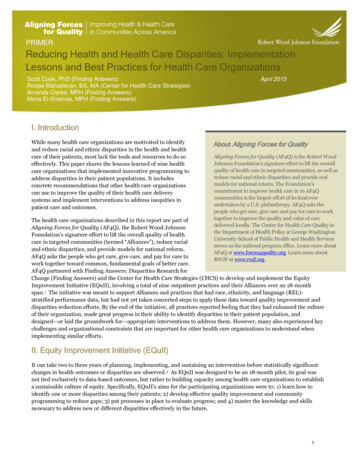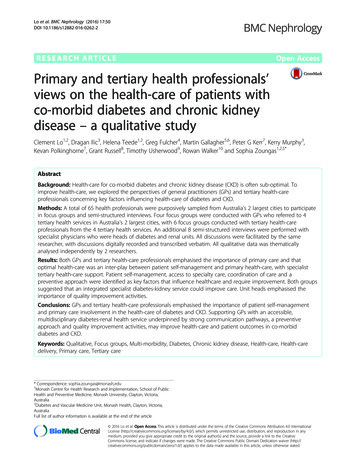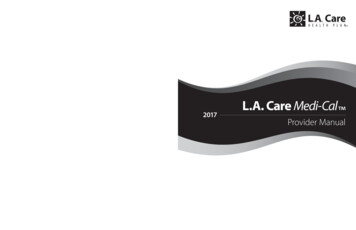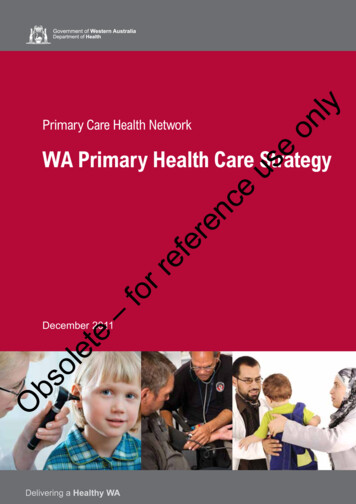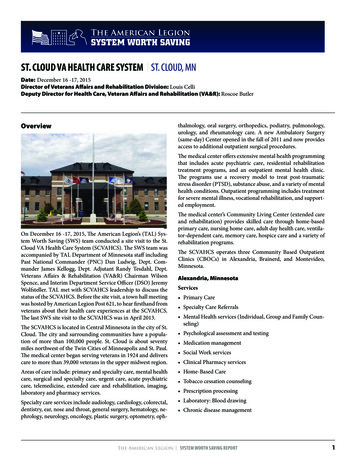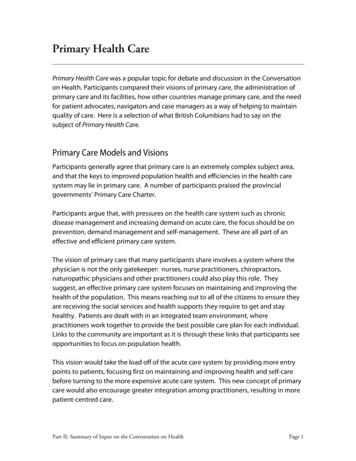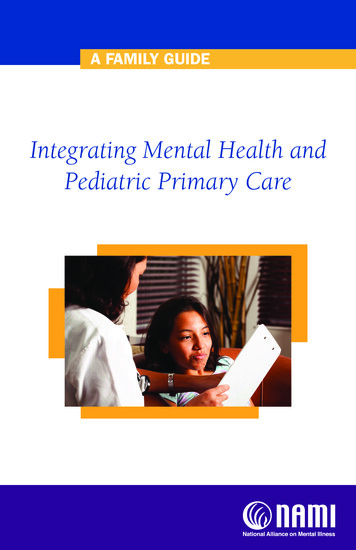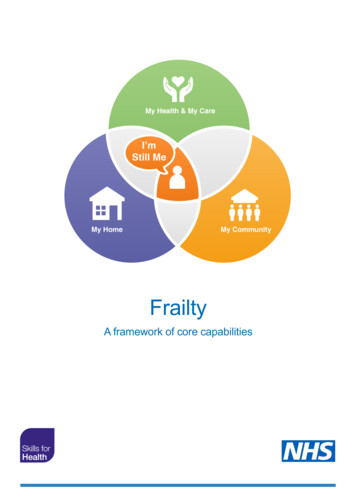
Transcription
My Health & My CareI’mStill MeMy HomeMy CommunityFrailtyA framework of core capabilities1
AcknowledgementsThis framework was commissioned by Health Education England and NHSEngland. This is a joint partnership publication by Skills for Health, NHS Englandand Health Education England.Development of the framework was steered by a project management group chaired by Dr Dawn Moody,Associate National Clinical Director for Older People and Integrated Person-Centred Care, NHS England.Project management was provided by Colin Wright, Frameworks Development Manager, (Skills forHealth) and Hilary Wyles, Senior Consultant, (Skills for Health).We are extremely grateful to members of the project management group for providing their guidance,expertise and support, in particular to Stephanie Hambleton (East Cheshire NHS Trust) for arrangingconsultation interviews and to David Russell for the plain English edit of the final text.The project management group included representatives of the following organisations: Age UK Heath Education England British Geriatric Society Local Government Association Centre of Excellence in Safety for Older People(CESOP) NHS RightCare NHS England Chartered Society of Physiotherapy Royal College of General Practitioners East Cheshire NHS Trust Skills for Health Foundations (National Body for HomeImprovement Agencies)In addition, we would like to thank the representatives of the following organisations which participated inthe project Expert Group: ADASS (Association of Directors of AdultSocial Services in England) NHS Chiltern Clinical Commissioning Group North West Ambulance Service NHS Trust Birmingham & Solihull Mental Health NHSFoundation Trust Petersfield Community Hospital Royal Bournemouth and Christchurch HospitalNHS Foundation Trust Royal College of Occupational Therapists Royal College of Nursing Society & College of Radiographers South Kent Coast Clinical CommissioningGroup Herefordshire Council (Adults & Wellbeing) Stoke on Trent City Council Southern Health NHS Foundation Trust British Dietetic Association British and Irish Orthoptic Society College of Paramedics College of Podiatry Hampshire Hospitals NHS Foundation Trust Hants Fire & Rescue ServiceIndependent advisor: John Lumley, EmeritusProfessor of Vascular Surgery Newcastle Gateshead Clinical CommissioningGroup2
We are also grateful to the many other people who provided comments and feedback on drafts of theframework during the project in particular, those living with frailty and their carers who participated inconsultation interviews and the 140 respondents to the online consultation survey.Further detail of how the framework was developed is presented in Appendix 3.Finally, we wish to thank the trustees of the Institute of Ageing and Health in the West Midlands forfunding further research to evaluate the impact of this framework.Equality and Health Inequalities StatementPromoting equality and addressing health inequalities are at the heart of our values. Throughout thedevelopment of the policies and processes cited in this document, we have: Given due regard to the need to eliminate discrimination, harassment and victimisation, to advanceequality of opportunity, and to foster good relations between people who share a relevant protectedcharacteristic (as cited under the Equality Act 2010) and those who do not share it; and Given regard to the need to reduce inequalities between patients in access to, and outcomes fromhealthcare services and to ensure services are provided in an integrated way where this might reducehealth inequalities. Health Education England, NHS England and Skills for Health 2018NHS England Publications Gateway Reference: 08406Copies of this framework may be made for non-commercial purposes to aid workforce development.Any other copying requires the permission of the publishers.3
ContentsForeword. .05Introduction and background.06Scope of the framework.0 7Structure of the framework.0 8About the three tiers.09Who is this framework for?.11Values and behaviours.14Domain A. Understanding, identifying and assessing frailty.15.Capability 1. Understanding frailty.16.Capability 2. Frailty identification and assessment.18Domain B. Person-centred collaborative working.20.Capability 3. Person-centred approaches.21.Capability 4. Communication.23.Capability 5. Families and carers as partners in care .25.Capability 6. Collaborative and integrated working .27Domain C. Managing frailty.29.Capability 7. Preventing and reducing the risk of frailty.30.Capability 8. Living well with frailty, promoting independence and community skills.32.Capability 9. Physical and mental health and wellbeing.34.Capability 10. Managing medication.36.Capability 11. Care and support planning.38Domain D. Underpinning principles.40.Capability 12. Law, ethics and safeguarding.41.Capability 13. Research and evidence-based practice.43.Capability 14. Leadership in transforming services.45Appendix 1. Glossary of terms.47Appendix 2. Principles of assessment.49Appendix 3. How the framework was developed.50Appendix 4. Current relevant resources.51Appendix 5. Bibliography.524
ForewordIt is frustrating to hear older people so often ‘defined’ by their need for health and care services, andthese needs so often referred to as a “burden” or in terms of “unnecessary” admissions to hospital. Thisfocus on concerns over the “cost” and “pressure” of helping more of us to live well in later life can distractfrom the many benefits, achievements and opportunities that come with an older and ageing society.There is instead a need to define and deliver an approach to care that builds upon the strengths ofindividuals, families and communities, and helps make the most of every contact an older person haswith health, care or other services. It is too often the case that opportunities to intervene early have beenmissed and a very real need for care arises that might otherwise have been avoided. Furthermore, healthissues that do not fit the neat boundary of a single condition or organ may end up going unaddressed.For some older people and their families, this is not only distressing and painful but can completelychange the trajectory of their remaining years.Though many older people will live in good health and hopefully experience a relatively short period ofpoor health at the end of their life, many others will be much more susceptible to ill health.“Frailty”, in simple terms is precisely that: even small shocks can have a big impact on a person and theirability to bounce back from these shocks can be much more difficult.Historically, professionals seeing someone as “frail” could mean they were thought of as “too difficult” orthat “nothing could be done”, even if only sub-consciously. Older people living with frailty and their carersdeserve much better. No matter where, or from whom, an older person is receiving care, they shouldexpect to receive support that fully recognises and understands their needs; that seeks out and takesaccount of their individual wishes and preference; and that focuses as much on the things they can do asit does on the health challenges they may be living with.We know that older people can be very uncomfortable with the word “frailty”, and this is understandable.However, by focusing on the things we know are important to improving their care and wellbeing, we canhelp to make the term ‘frailty’ a passport to the kind of support that makes a real difference to their healthand lives.I am very pleased to support this frailty core capabilities framework and hope it will support a positive andlong-lasting shift in how we work with older people to identify, understand and meet their needs.Baroness Sally Greengross OBEBaroness Sally Greengross has been a crossbench(independent) member of the House of Lords since 2000and Co-Chairs four All-Party Parliamentary Groups:Dementia, Corporate Social Responsibility, Continence Careand Ageing and Older People. Sally is Chief Executive ofthe International Longevity Centre and is a former DirectorGeneral of Age Concern.5
Introduction and backgroundHealth Education England and NHS England commissioned the development of this core capabilitiesframework to improve the effectiveness and capability of services for people living with frailty.Frailty is a long term condition related to the ageing process in which multiple body systems graduallylose their in-built reserves. It is now widely recognised as a state of reduced resilience and increasedvulnerability, which results in some older people becoming more vulnerable to relatively minor changes intheir circumstances which can lead to a deterioration in their health and/or ability to live independently. Itis estimated that around 50% of people over the age of 65 are living with some degree of frailty and somewho experience frailty earlier in life1.People living with frailty are less able to adapt to stress factors such as acute illness, injury or changesin their environment, personal or social circumstances, and such changes are more likely to result inadverse health outcomes and loss of independence.There is some evidence to suggest that the term frailty might not resonate with older people or theirfamily members or care givers. However, frailty is a useful concept because it can help us to recogniseand provide for the needs of people living with this long term condition. We, therefore, use the term‘frailty’ in this framework, although recognise that many people living with frailty might not recognisethemselves as such, but may more often describe themselves using terms such as ‘I’m slowing down’.One of the aims of this framework is to empower people living with frailty, as well as their family, friendsand carers, to understand the condition, make the most of available support and to plan effectively fortheir own current and future care needs.Frailty also remains a new area for much of the workforce and work is now needed to position frailty as along term condition and underpin it with the upskilling of the workforce. Recent research has highlightedthe current variation and inconsistency in education and training and the siloed working that still existsbetween different sectors and professions which can be particularly problematic in care of older people2.This framework aims to identify and describe the skills, knowledge and behaviours required to deliverhigh quality, holistic, compassionate care and support. It provides a single, consistent and comprehensiveframework on which to base review and development of staff.Better identification of frailty and better understanding of how to support people to live well with frailty isincreasingly recognised as one of the key challenges for health and care systems in the 21st Century.In England, support for older people living with frailty is acknowledged as a priority in the NHS Five YearForward View and Next Steps on the Five Year Forward View.The framework builds upon, and is cross-referenced to, existing core skills frameworks such as those forstatutory/mandatory subjects, dementia, end of life care and person-centred approaches (details of theseframeworks are available at: www.skillsforhealth.org.uk/cstf).Further information on the development of this framework is presented in Appendix 3.1. Clegg A et al (2016), Development and validation of an electronic frailty index using routine primary care electronic health record data2. Picker Institute/Dunhill Medical Trust (August 2018): Exploring education and training in relation to older people's health and social care6
Scope of the frameworkThe framework will be applicable to health, social care and other employers, employees, people livingwith frailty, carers, the community, the public and also to educational organisations which train studentswho will subsequently be employed in the workforce.The framework aims to describe core capabilities. For the purposes of this framework we are using thefollowing definitions:Core:common and transferable across different types of service provision.Capabilities: the underpinning knowledge, skills and behaviours which give a person the potentialto become competent - capabilities can be the outcomes of education, training orexperience.The scope of this framework is described in 3 tiers (see page 9 for further details):Tier 1:Those that require general awareness of frailty.Tier 2:Health and social care staff and others who regularly work with people living with frailty but whowould seek support from others for complex management or decision-making.Tier 3:Health, social care and other professionals with a high degree of autonomy, able to providecare in complex situations and who may also lead services for people living with frailty.Beyond the scope of this framework, further guidance for Advanced Clinical Practice is available ractice/multi-professional-frameworkOther relevant frameworks are also referenced in each capability.7
Structure of the frameworkThe framework begins with a description of values and behaviours which underpin all capabilities in thisframework.The framework then comprises 14 capabilities, which are numbered for ease of reference and grouped in4 domains:Domain A. Understanding, identifying and assessing frailtyDomain B. Person-centred collaborative workingDomain C. Managing frailtyDomain D. Underpinning principlesThis does not indicate a prescribed pathway, process or hierarchy. Full coverage of all capabilities mayalso be achieved by teams, in which case some team members may find that not all capabilities arerelevant to their individual role.Within each of the capabilities, the required knowledge, skills and behaviours are presented for 3 tiers,relevant to particular people or practitioners, i.e.The person or practitioner will:Be aware of.has an awareness of a conceptKnow utilise previously learned informationUnderstand demonstrate a comprehension of the factsBe able to apply knowledge, understanding and skills to actual situationsAnalyse examine and break information into component parts in order to evaluate thesignificance and interrelatedness of each componentSynthesise build a structure or pattern from diverse componentsEvaluate present or defend opinions by making judgements based on informed reflective criticalthinking and underpinned by critical self-awareness3Most outcomes at tiers 1 and 2 describe awareness, knowledge, understanding and application, althoughthere are some outcomes (particularly at tier 3) which may include analysis, synthesis and evaluation.The outcomes for each capability should together indicate the minimum content for the design anddelivery of teaching and learning for each tier.The outcomes are written as broad statements e.g. ‘The person or practitioner will: be aware of / know /understand / be able to ’ This provides scope for the framework to be applicable across a wide range ofcontexts and setting.3. This approach is derived from Bloom’s Taxonomy (Bloom B, 1956),8
About the three tiersThe core capabilities described in the framework are defined for three tiers:Tier 1Those that require general awareness of frailty.This tier is relevant to people living with frailty, as well as their family, friends and carers, to ensure theyare making the most of the support on offer and can plan effectively for their own current and future careneeds. This tier is also for all those working in health, social care and other services who have contactwith people with frailty including those who will go on to further training at tiers 2 and 3.This tier will be relevant to you if: you are an interested member of the public you are living with frailty you support someone living with frailty you work in adult health, social care sector or other sectorsTier 2 Health and social care staff and others who regularly work with people livingwith frailty but who would seek support from others for complexmanagement or decision-making.This tier is for those who provide care and support for people living with frailty as part of their work, butwho would not be responsible for complex decisions regarding management of frailty.This tier may be relevant to you if you work in; health or social care (including home care and care homes) emergency services housing support local authority servicesTier 3Health, social care and other professionals with a high degree of autonomy,able to provide care in complex situations and who may also lead servicesfor people living with frailty.This tier is for those with responsibility for complex decision-making and to whom others refer formanagement, guidance and support.This tier may be relevant to you if you work in; health or social care (including home care and care homes) emergency services housing support local authority services9
The framework is incremental, i.e. tiers 2 and 3 assume that the person or practitioner possess the skillsand knowledge at preceding tiers (to minimise unnecessary repetition). Those generally at tier 1 or 2 mayalso wish to explore some capabilities at higher tiers.Additional specialist or organisation-specific skills and knowledge are outside the scope of theframework. Such additional capabilities may be locally determined to meet needs in specific settings, forexample according to local context, risk assessment or policy.Figure 1 below illustrates the relevance of the three tiers to different audiences:You have personal experience of living with frailty,either in your own life or in providing care andsupport for family or friends.Tier 1 is most likely to meet your needsYou work in adult health, social care or othersectors but have limited contact with anyoneliving with frailty.Tier 1 is most likely to meet your needs,but depending on the nature of your roleyou may wish to explore Tier 2requirements for some capabilitiesYou work in adult health, social care or othersectors with a role which includes meeting theneeds of people living with frailty - but you referto others for complex management ordecision-making.Tier 2 is most likely to meet your needsYou work in adult health, social care or othersectors with a high degree of autonomy, ableto provide care in complex situations.Colleagues refer to you for opinions, adviceor further support. You may also leadservices for people living with frailty.Tier 3 is most likely to meet your needsThe framework emphasises a person-centred approach, with shared decision makingbetween the individual receiving care and the person delivering care.10
Who is this framework for?People living with frailty and their family, friends and carersThe framework can be used by people living with frailty to understand how to make the most of thesupport on offer and to plan effectively for their own current and future care. In particular, the frameworkhighlights that people living with frailty must be able to make informed choices about effective care andsupport alongside healthcare and other practitioners, i.e. to participate in shared decision-making.Tier 1, therefore, includes a community development approach to care which encourages individuals tolook beyond traditional care provision, ask ‘what is important to me?’ and how this could be achievedalongside care and support from health, social care and other professionals. This might include: thestrengths and abilities of people with frailty; the strengths and abilities of their family, friends and carers;and the potential of the community to provide care and support. This way of working that considers thestrengths and potential of individuals and communities is often described as an ‘asset-based’ approach tocare.Practitioners – individuals and teamsThe framework sets out clear expectations for those working in health, social care and other services tobe clear about the requirements of roles and transferable skills. It can be used to review and recognisehow capabilities are shared across teams and to conduct formal or informal training needs analysis,comparing current skills and knowledge with required skills and knowledge. The framework also providesa structure for career progression and engagement in continuing professional developmentand/or revalidation.Service providersThe framework enables managers to demonstrate that staff meet core capabilities or have developmentalplans in place to meet the nationally recognised framework. This underpins the continuing professionaldevelopment of practitioners to ensure their practice remains up-to-date, safe and effective.A further aspiration in providing this framework is to support service improvement through development ofa flexible and adaptable multi-professional workforce to support new models of care. Organisations canuse the framework to review their current arrangements for people living with frailty; the aim is to ensureall staff have an awareness of frailty and those who regularly work with people living with frailty are skilledin areas such as assessment, prevention and supported self-management advice in accordance withtheir scope of practice.Use of this national framework also supports organisational and system-wide effectiveness andefficiencies by encouraging the delivery of education and training that is focused on developing corecapabilities and optimises opportunities for inter-professional learning. In so doing, it should help toincrease consistency in knowledge and skills development, prevent unnecessary duplication in educationand training delivery and strengthen skill mix and team-working.Service commissionersThe framework enables commissioners of services to specify minimum standards of care for peopleliving with frailty; it sets out clear expectations about what different ‘tiers’ of the workforce are able todo. It also supports service improvement, for example by using the framework to review current serviceprovision for people living with frailty and to support collaborative approaches to commissioning.11
Education and training providersThe framework helps those who design and deliver training and development opportunities to focus onthe key capabilities that learners need to achieve, which in turn will guide the content to be included andthe use of appropriate learning and teaching strategies. The framework can also be used to support theanalysis of learning needs and assessment; the principles of assessment are presented in Appendix 2.In particular, by using the framework to inform the design of education and training curricula, universitiesand colleges can ensure that the core capabilities are appropriately reflected within intended learningoutcomes. This will help ensure that students on placements or new graduates entering the workplacehave already gained the core capabilities when they enter practice and when practitioners prepare totake on a new role.Figure 2 below represents the range of people and services to whom this framework ndaryCareHome CareWorkersOpticiansAllied ghboursDentalServicesMy Health & My Care,·PStill 0\ RPHLocalAuthority0\ usDriversFamily12PoliceLeisureFacilitiesFire & RescueService
The capabilities in this framework are consistent with the ‘I statements’ developed by National Voices,UCL Partners & Age UK (2014):Independence I am recognised for what I can do rather than assumptions being made about what I cannot I am supported to be independent I can do activities that are important to me Where appropriate, my family are recognised as being key to my independence and quality of lifeCommunity interactions I can maintain social contact as much as I wantDecision making I can make my own decisions, with advice and support from family, friends or professionals if Iwant itCare and support I can build relationships with people who support meI can plan my care with people who work together to understand me and my carer(s), allow mecontrol, and bring together services to achieve the outcomes important to meTaken together, my care and support help me live the life I want to the best of my abilityRef: National Voices, UCL Partners & Age UK (2014), I'm Still Me: A Narrative for Coordinated Supportfor Older People at: les/public/publications/im stillme.pdfreturn to contents page13
Values and behavioursThe following values and behaviours for health, social care and other staff underpin all the capabilities inthis framework and focus on the expectations of people with frailty, their family and carers. These valuesand behaviours are supplementary to any existing legal, regulatory and ethical requirements or codesrelevant to professional bodies and employers.The practitioner will:a) show people respect and compassion, without judging themb) be patient and really listenc) show interest in people, and that you understand their perspective, preferences and what is importantto them, their families and their carersd) value and acknowledge the experience and expertise of people, their families, their carers andsupport networks, enabling choice and independence as far as is practicablee) act with integrity, honesty and openness, seeking to develop mutual trust in all interactions withpeople, their families, carers and communitiesf) be committed to ensuring integrated current and future care, support and treatment, through workingin partnership with people, teams, communities and organisationsg) value collaborative involvement and co-production with people to improve person-centred design andquality of servicesh) recognise, respect and value peoples’ differences and challenge negative stereotyping (e.g. in age,race, disability, sexuality, gender, religious, ethnic and cultural backgrounds)i) recognise that people with impaired cognition or learning disabilities and their families have the samehuman rights as othersj) take prompt action where there is an issue with the safety or quality of care, raising and escalatingconcerns where necessaryk) take responsibility for one’s own learning and continuing professional development, and contributingto the learning of othersreturn to contents page14
Domain A.Understanding, identifying and assessing frailtyIntroductionLife expectancy is increasing and many people are enjoying healthy lives in older age. However, atthe same time some older people have reduced resilience and increased vulnerability to relativelyminor changes in their circumstances, which can lead to deterioration in their health and ability to liveindependently. This condition is now recognised as frailty and is often described by individuals with thecondition as a feeling that they are slowing down, losing strength or finding it more difficult to performeveryday tasks. Frailty becomes more common as age increases. However, it is not an inevitableconsequence of getting older and can also occur at a younger age, for example vulnerable groups(such as the homeless) with a lower mortality rate may experience frailty earlier in life. Identifying peoplewho are living with frailty, therefore, offers an important opportunity to identify those people who are atgreatest risk of deterioration in their health, wellbeing and ability to live independently.Increasing the awareness and understandin
Royal College of Nursing Society & College of Radiographers South Kent Coast Clinical Commissioning Group Stoke on Trent City Council Southern Health NHS Foundation Trust In addition, we would like to thank the representatives of the following organisations which participated in the project Expert Group:
